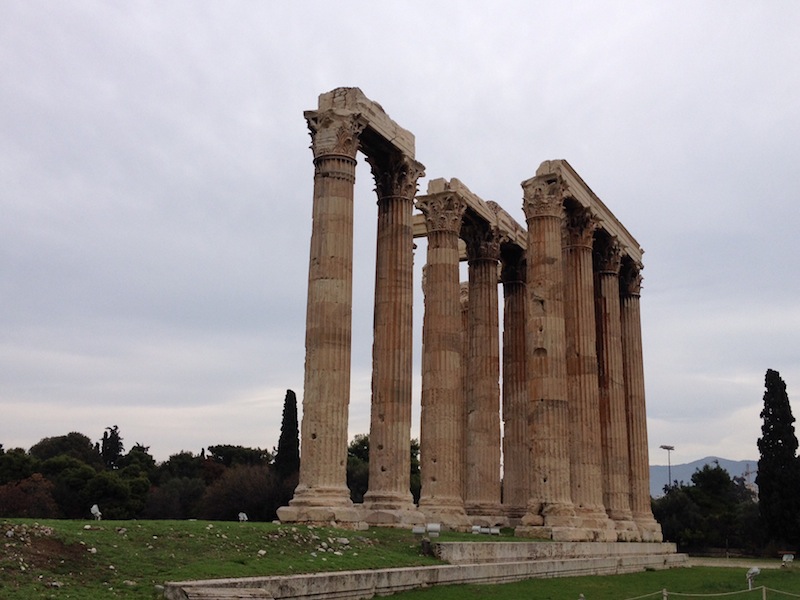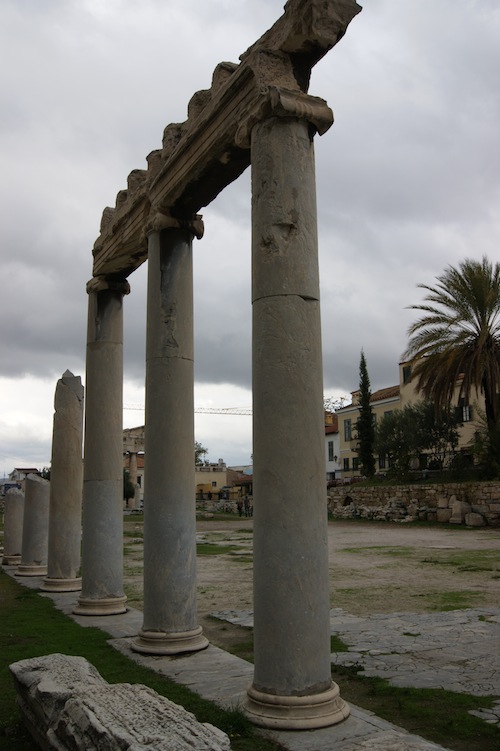After the arid months of summer, Athens becomes a city of green hills in autumn. And we spent our second full day in the city exploring one of them – Filopappos Hill.
Not that I had much energy in the morning thanks to a grotty night of sleep. Our hotel, the Herodion, was proving to be a big disappointment.
We filled ourselves with fuel at breakfast and went out to find the footpath that would take us to the top of Filopappos, just a short walk from the hotel. We left behind the noisy coaches and open-top buses that were gathered there and soon found peace on our gentle climb through the olive groves and pines, along the prepared marble paths.
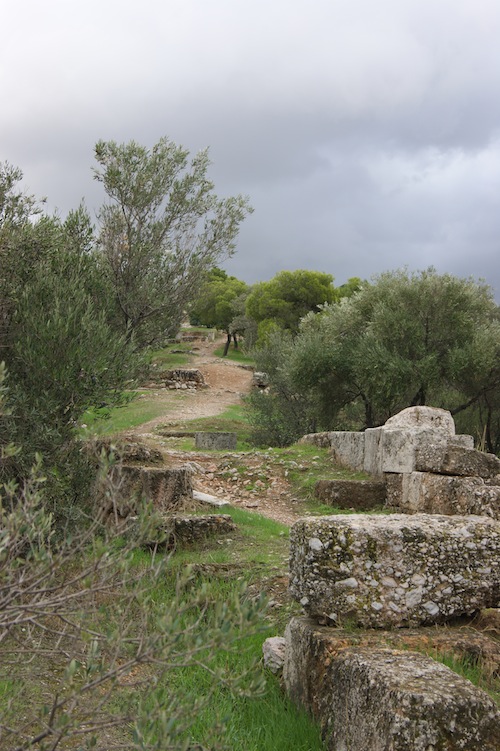
The views across to the Acropolis were made to be captured on film, and were ruined only by the scaffolding that embraced the stone columns. The views across the rest of the city were just as good, down to the sea, the beaches of Glyfada and the port of Piraeus.
We walked past the remains of fortifications that helped protect the then much smaller city of Athens in ancient times, stopping to take in the views, passing a couple of elderly Brits eating an early lunch. Dogs barked all around.
At the top of the hill we found the remains of the funeral monument that gives the hill its name, built in 115 AD in memory of the Roman consul Gaius Julius Antiochus Philopappos. In truth, there’s not much to admire and it looks much grander from afar but at least we’d stretched our legs and seen a greener side of Athens.
We walked back down through the woods to what I thought would be the Thisio district but my normally excellent sense of direction had deserted me and we ended up further south. Still, that meant we discovered a site at the bottom of the hill that was once home to ancient stoas (grand walkways), and rooms that had been built into the rock. We climbed ancient stairs carved into the hill that once led to locals’ homes.
I couldn’t believe that, back in the early 20th century, a giant modern amphitheatre had been built over such an historic site. It was subsequently ripped out and the archaeology visible today revealed once again.

The back streets of Thisio were quiet that morning, locals going about their business as we navigated streets caked in dog shit to find a cafe for a rest and a reviving coffee. The sun broke through and brought with it heat as we walked back through the Monastiraki flea market, familiar from the day before but a lot busier.
The Roman Forum was our next target. A plot of several acres, dotted with giant columns, it was clearly once an important trade and civic complex but unfortunately several of its features – an ancient church and an historic astronomical tower called the Tower of the Winds – were clad in scaffolding and tarpaulin.
If nothing else, our visit to Athens had been timed to coincide with a big programme of renovation and restoration. Indeed, a few hours later we found ourselves at the city’s cathedral, which was also plastered in scaffolding, inside and out.
We stopped for lunch in the atmospheric, historic streets of Plaka, which clamber up the hill towards the Acropolis and where the restaurant touts were out in force. A stooping old man persuaded us to stop at his place so we indulged him and, sitting outside on a mild November day, drinking Mythos and chewing on tasty lamb chops, I was glad that we did. A friendly black and white cat mewed for attention and scraps. Up there, amid the charming alleys and steps, it was like being in a small village on a Greek island rather than slap bang in the middle of the nation’s capital city.
We spent another hour exploring the shopping streets of Plaka but they were rather less appealing, an endless chain of places selling the same tacky souvenirs, olive oil products and jewellery. Various ‘art’ galleries and stalls pointed to the dismal taste of some locals and the tourists who kept such places in business. And many were lit with the sort of neon lights that could burn a retina at a thousand paces.
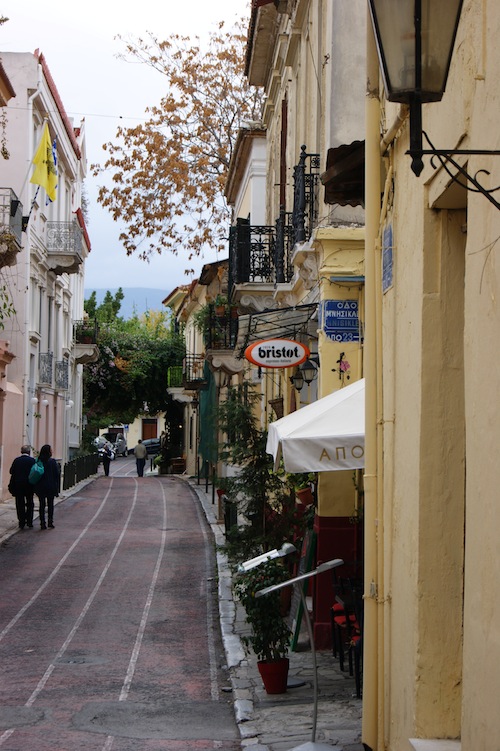
We stopped for more beer at the Yard Cafe (again) before heading home for a much-needed nap – needed to burn off all the alcohol we’d consumed.
Come the evening we returned to Plaka. Busy with Saturday evening crowds, lights twinkling from darkened windows, the sounds of people having a good time – it all made for a lovely destination.
We avoided the persistent touts and found a place called Psara right at the top of the hill, away from most of the crowds and free of the most insistent of waiters. Indeed, the service was the friendliest so far in Athens and the food was pretty good too. I opted for Greek sausages and moussaka. We sat outside in the cool evening air, candles burning on the tables and on the steps that wound their way through the neighbourhood. Sheltered by trees, the stars above us, it was a truly romantic spot.
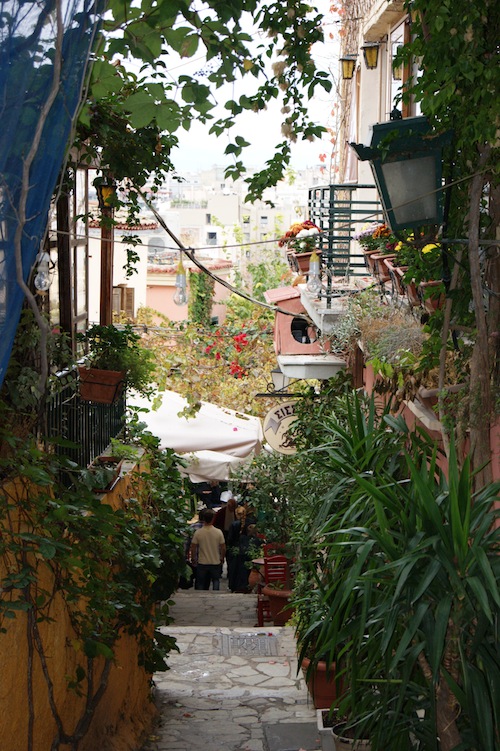
We ended our night in a couple of bars around Psirri, me on the beer, G on the red wine, the soundtrack a collection of 80s hits and Greeks making merry.
Our last day in Athens dawned cloudy and I was feeling the effects of too much interrupted sleep (and lager). Despite leaving the patio doors open, the heat was still great in the room and there was no way to control it. In fact, the entire hotel was sweltering.
Before packing we walked out in the quiet of a Sunday morning to Hadrian’s Gate and the Temple of Olympian Zeus. Just a few streets away from the hotel, it’s difficult to miss the towering columns that remain from the temple as you walk around the neighbourhood. Close up, they’re truly monumental survivors. The surprise is the column that tumbled over in a fierce storm in the 19th century, its constitutents parts laid neatly like tumbled lego.
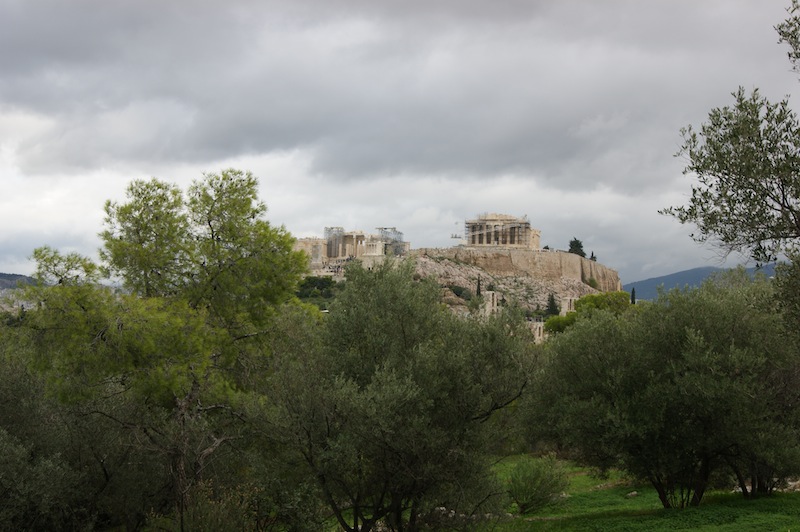
An hour or two later we were in a taxi to the airport. The journey took us through the outskirts of the city, past a string of lap-dance clubs, down to the sea. There, outside the historic heart of Athens, were the signs of the economic woes Greece has experienced in recent years. Numerous buildings lay derelict. Some of them offices, others factories but most of them shops.
Even the old Athens airport looked undeveloped and we spotted some stadia from the 2004 Olympics looking neglected, shrouded in weeds and locked. Talk about a waste of money… The overwhelming impression, as we drove through scrubby suburbs, was one of despair.
It made for a gloomy goodbye to Greece.

